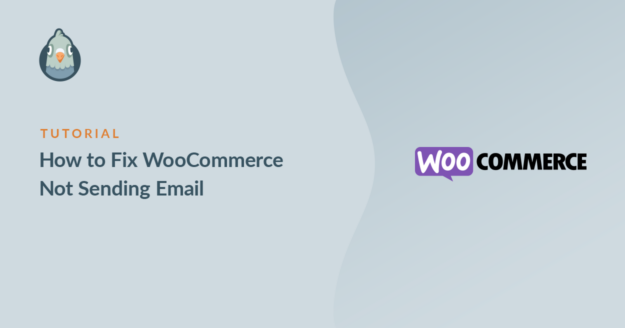AI Summary
To run a successful online store you need to be able to communicate reliably with your customers. When WooCommerce isn’t sending emails properly, it can disrupt your business workflow and leave customers uncertain about their purchases.
If you’re having issues with WooCommerce not sending order emails, confirmation receipts, and shipping updates, you’re in the right place
In this guide, I’ll walk you through some solutions I’ve used personally to fix WooCommerce not sending emails. You’ll learn how to:
- Diagnose the exact cause of your email delivery problems
- Configure your WooCommerce email settings
- Use the WP Mail SMTP plugin to make sure your emails land in your customers’ inboxes
Follow these steps to get your WooCommerce emails back on track.
Fix Your WooCommerce Emails Now
How to Fix WooCommerce Not Sending Emails
If you or your customers aren’t receiving WooCommerce emails like order confirmations and notifications, the most likely cause of the problem is that you’re relying on the built-in email function within WordPress.
WordPress uses the wp_mail() function to send email, which is pretty basic and not very secure. Some web hosting providers block this function so your emails won’t send at all. But even if they do, emails sent with this method may be blocked or sent to the spam folder because they aren’t authenticated.
Luckily, there’s an easy way to fix this issue with the WP Mail SMTP plugin. WP Mail SMTP sends your WordPress site’s emails via secure SMTP to make sure your messages reach the inbox reliably.
WP Mail SMTP lets you choose between many email providers according to your budget and the number of emails sent from your store. First, let’s check some basic settings in your email templates.
- Step 1: Check WooCommerce Email Notification Settings
- Step 2: Install WooCommerce SMTP Plugin
- Step 3: Check the From Email in WooCommerce
- Step 4: See Sent WooCommerce Order Emails
- Step 5: Resend WooCommerce New Order Notification
- Step 6. Monitor WooCommerce Email Deliverability
- FAQ about WooCommerce Order Notification and Email Issues
Step 1: Check WooCommerce Email Notification Settings
To start, we’re going to look at some common problems with WooCommerce not sending emails.
When you start an online store with WooCommerce, it’ll create a set of order statuses, including:
- Pending – Payment hasn’t been received yet
- Processing – Payment has been received and the order is confirmed
- Completed – The order has been shipped.
WooCommerce sends emails automatically when an order moves from one status to another. But if the emails aren’t set up correctly, you and your customer might not receive them.
So to fix WooCommerce auto email errors, the first thing we want to check is that we have the right emails set up and they haven’t been deactivated.
When you encounter issues with WooCommerce emails, open up your WordPress dashboard. Then from the left-hand navigation, go to WooCommerce » Settings.
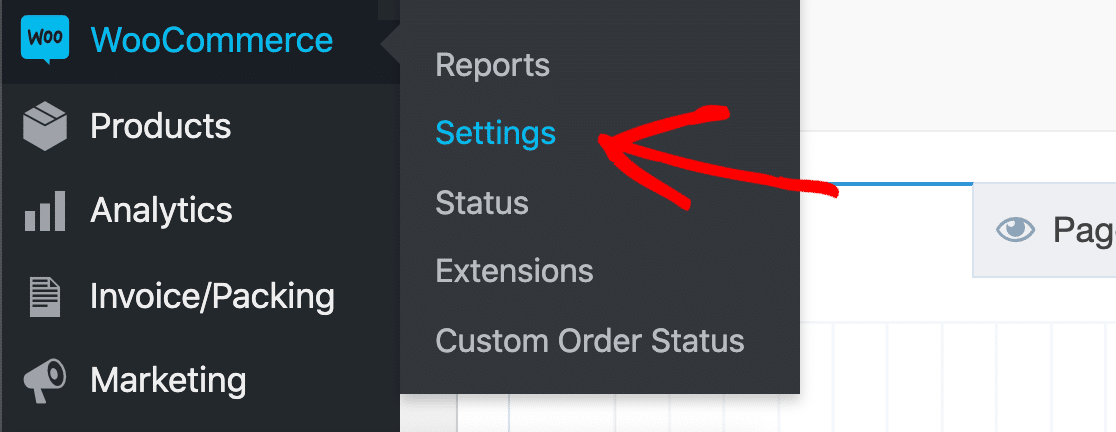
Look to the tabs across the screen and click the Emails tab.
In this list, you’ll see all of the emails that should be sent from your store. You can check each email template by clicking the Manage button on the right.
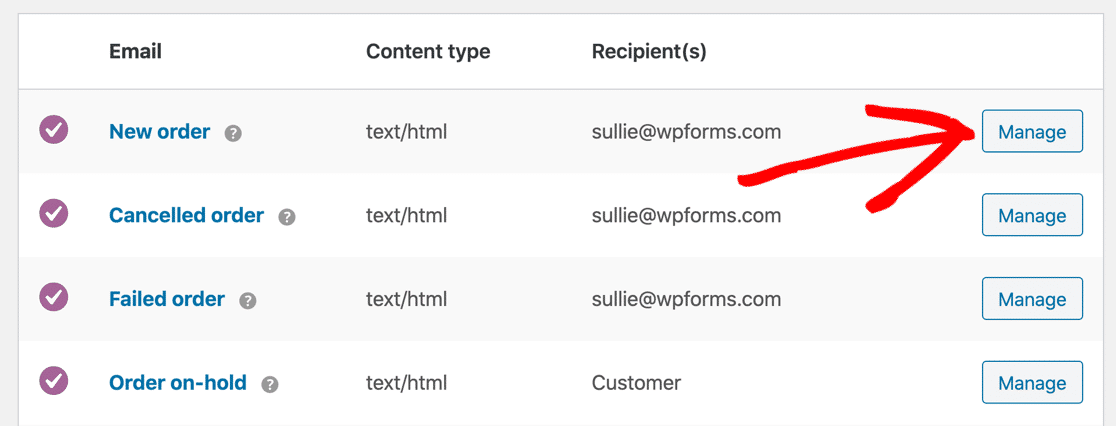
In the email template, make sure that the box next to the Enable this email notification option is checkmarked. Note that if the email is sent to the customer, there won’t be a Recipient(s) field here.
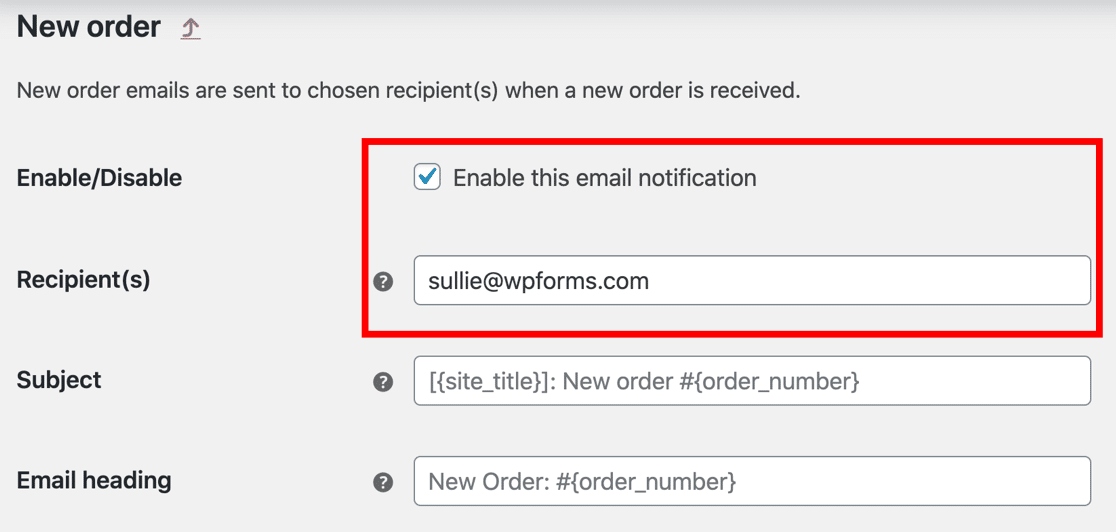
If you do see a Recipient(s) field, check that the notification has the correct recipient address.
Sometimes emails get disabled by accident, which can be a reason for WooCommerce not sending emails. So while you’re on this screen, check out each template and make sure all of the emails are enabled.
If everything looks good, let’s check that new orders are coming in with the right status.
Check Payment Status in WooCommerce
When you get an order in WooCommerce, it will be assigned a status automatically. If payment has been taken, it should show as Processing.
If you see that new orders have a different status, it might mean that WooCommerce is not sending emails because the status is being set to something else.
To check, go to WooCommerce » Orders.
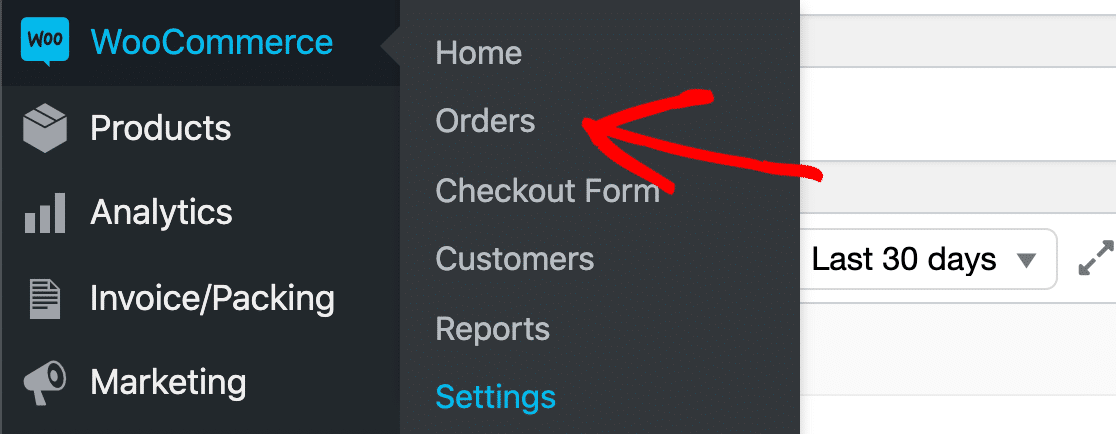
Now check the status of your recent orders. If you don’t have any, you’ll want to create a test order and then check the result here:
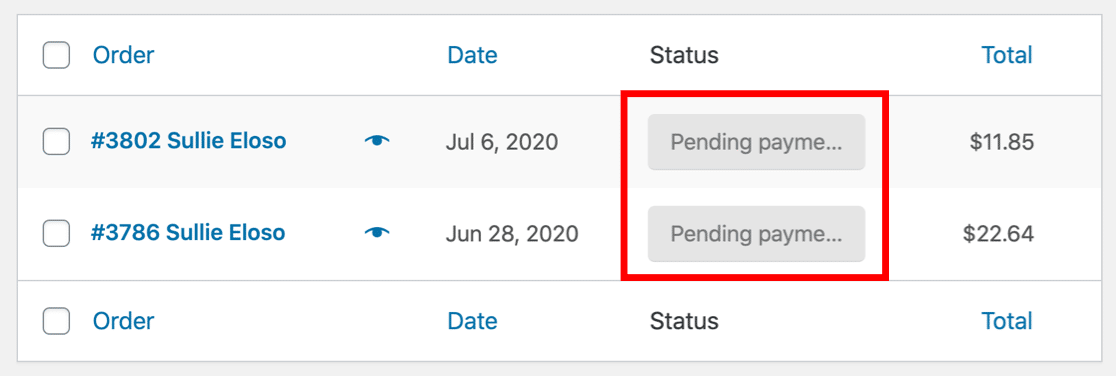
In this example, the orders are in the Pending status. By default, the Pending status doesn’t send any order emails, so this could explain why WooCommerce isn’t sending out notifications when you expect it to.
Are your emails going into Pending and you’re not sure why? It might be because:
- The order was abandoned: The customer ordered something but left before completing payment
- Payments are failing: Your payment gateway is initiating payments but failing to complete them
- Manual payment is needed: You have a manual payment method set up, like a bank transfer, and you need to manually confirm that the bank transfer has been received.
If your orders show the status of Processing, then both you and the customer should have received an email. If that’s not happening, it’s likely the WooCommerce emails are going to spam.
This is 1 of the most common reasons for WooCommerce not sending email to customers. Let’s set up WP Mail SMTP now to fix the problem.
Step 2: Install WooCommerce SMTP Plugin
In this step, we’re going to install WP Mail SMTP to fix issues with your order emails.
WP Mail SMTP is the best SMTP plugin for WordPress. It lets you easily send WooCommerce order emails through a 3rd party email provider like SendLayer, Brevo (formerly Sendinblue), or SMTP.com.
Need a hand setting up WooCommerce SMTP?
Our Elite license includes White Glove Setup for SendLayer, SMTP.com, or Brevo.
You can use either the Lite (free) version of WP Mail SMTP or pay for a license. If you want to use the free version, you can follow the start of this tutorial to activate and setup the plugin. This should be enough to fix most WooCommerce email problems.
If you upgrade to a paid license, you’ll get access to lots of features that will help you to troubleshoot any issues with your WooCommerce emails such as email logs, email failure alerts, and backup connections. We’ll cover how to use these features later in the tutorial.
If you want to start with the free plugin, you can add it to your WordPress site by navigating to Plugins » Add New Plugin and searching for “WP Mail SMTP”. Click the Install Now and then the Activate button in the plugin description.
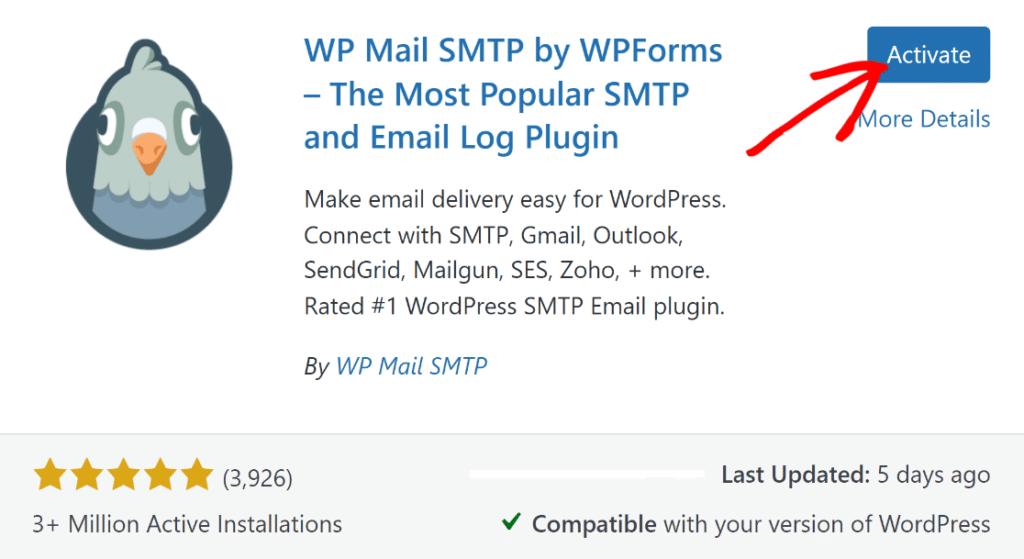
If you’ve bought the Pro version of WP Mail SMTP, you can download the zip file from your WP Mail SMTP account to start. You’ll find it in the Downloads tab when you log in to your Account area.
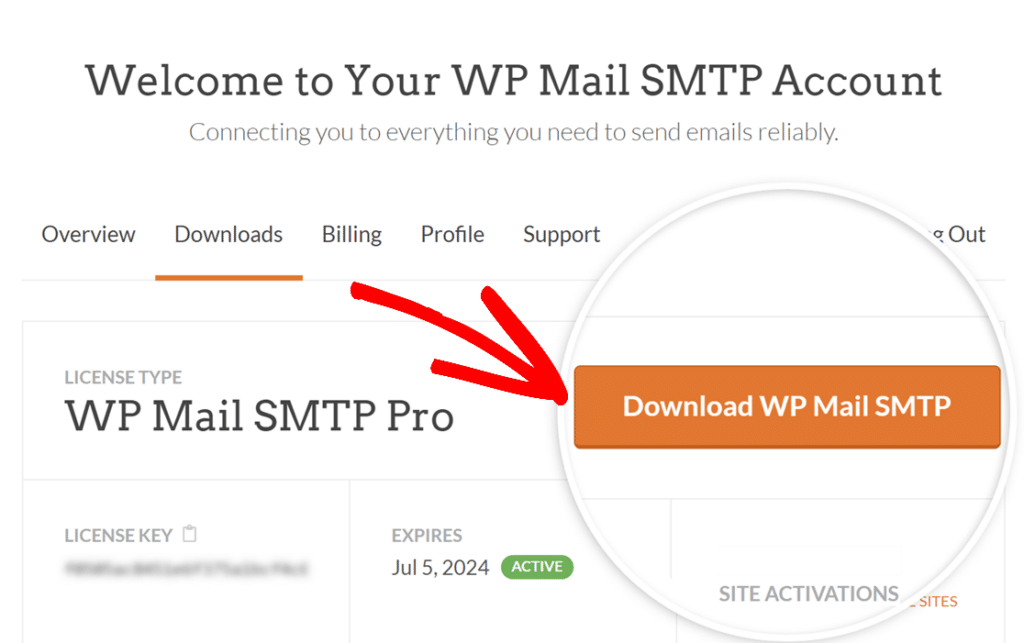
Next, open up the WordPress dashboard and upload the plugin manually. If you’re not sure what to do here, read our guide to installing a WordPress plugin.

Don’t forget to Activate the plugin. As soon as you activate it, the Setup Wizard will open.
You can also start the wizard at any time by clicking the Launch Setup Wizard button in your WP Mail SMTP settings.
Set Up Your WooCommerce SMTP Service
Now let’s run the wizard to set up your WooCommerce SMTP.
Remember, if you already have a provider set up, running the wizard a second time might erase your settings, so it’s best to do this just once.
First, click the Let’s Get Started button.
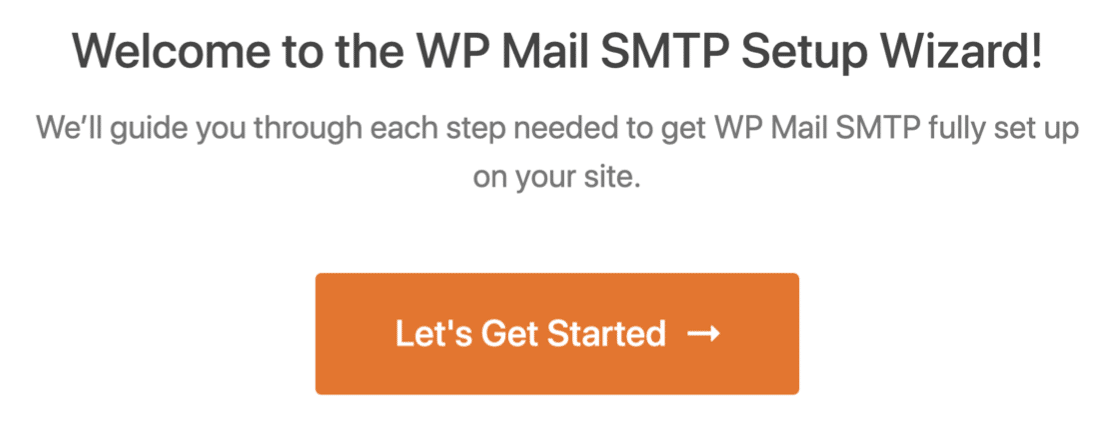
And now select the email service you want to use.
Having a reliable email service provider is especially important for online stores. That’s why we recommend SendLayer, SMTP.com, or Brevo. These 3 services can handle large numbers of transactional emails, which is super important if you have a busy store.
For example, SendLayer lets you start sending emails for free. Pricing steps up from there if you need more capacity. All you need are the API credentials provided when you sign up. SendLayer has a step-by-step guide to setting up WooCommerce emails, which you’ll definitely find useful if you choose it as your email provider.
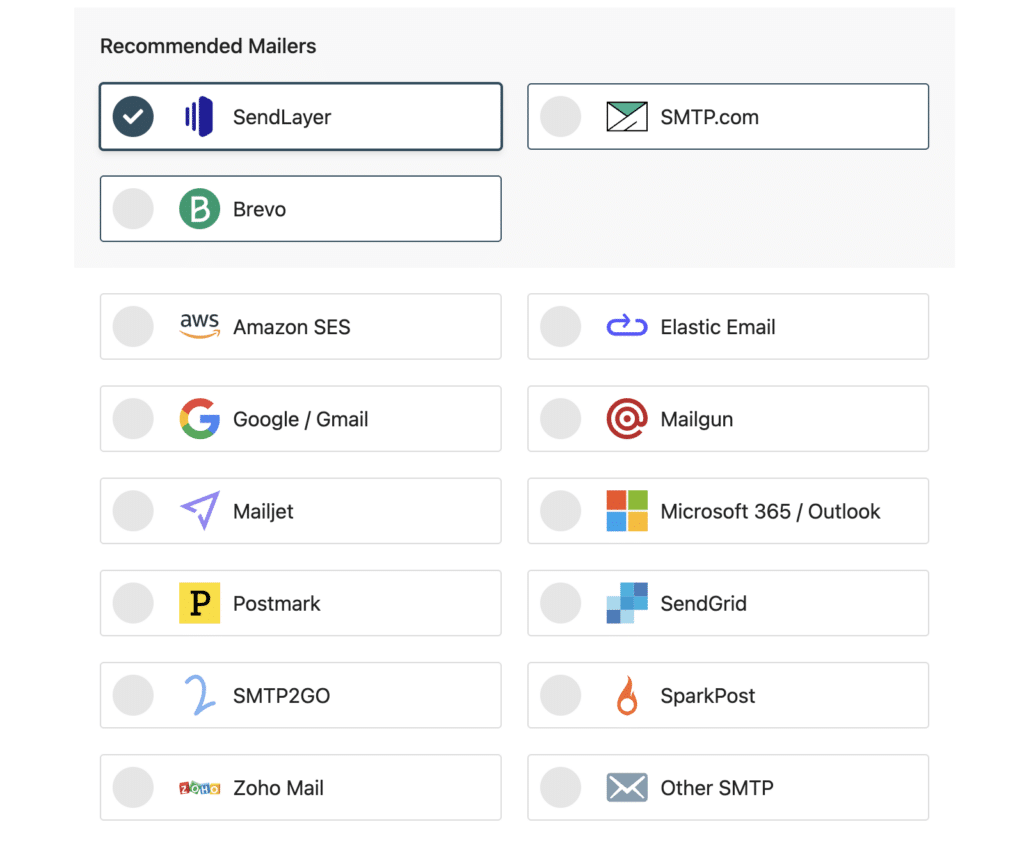
If you want, you send emails through the Gmail API, Google Workspace, or an SMTP server. But keep in mind that these mailers have lower sending limits compared to transactional email providers.
For that reason, using Gmail or Other SMTP will work best for small stores that don’t generate tons of order confirmations.
When you’ve chosen your mailer, open up our documentation to complete the setup steps on the provider’s side:
| Mailers available in all versions | Mailers in WP Mail SMTP Pro |
|---|---|
| SendLayer | Amazon SES |
| SMTP.com | Microsoft 365 / Outlook.com |
| Brevo | Zoho Mail |
| Google Workspace / Gmail | |
| Mailgun | |
| Postmark | |
| SendGrid | |
| SparkPost | |
| Other SMTP |
If you want to set up multiple mailers, you can do so in the Additional Connections settings once you’ve finished the Setup Wizard. Then you can select a Backup Connection and configure Smart Routing.
During the Setup Wizard, you may see a From Email setting. This is an important setting that’ll apply the right authentication, so we’ll explain it more in the next step.
Step 3: Check the From Email in WooCommerce
The From Email is an important setting for WooCommerce email notifications. We recommend that you force the same From Email across your website to make sure your WooCommerce emails don’t go to spam.
During the WP Mail SMTP Setup Wizard, you’ll be shown the From Email option. Depending on your email service provider, the From Email may be grayed out, or it may appear as a dropdown list.
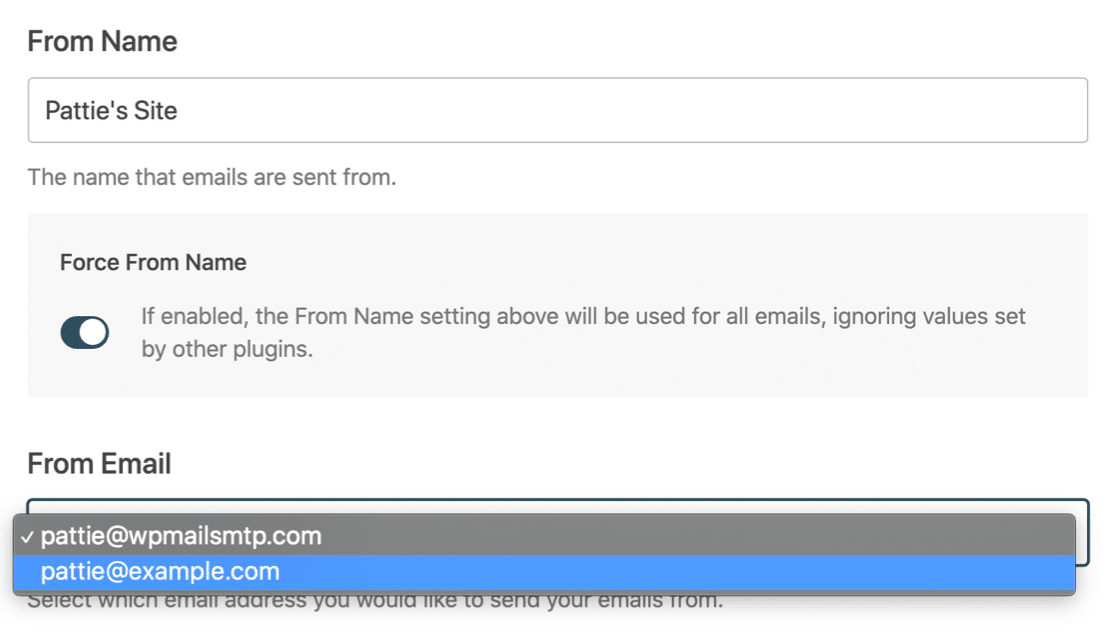
Type in the From Email that you want to use and enable the Force From Email toggle. If you see a dropdown when using Gmail, you can select one alias as a From Email and force that across your entire store.
If you want, you can also turn on the Detailed Email Logs in WP Mail SMTP Pro. Let’s look more closely at this so you can decide if it’s right for you.
Step 4: See Sent WooCommerce Order Emails
At the end of the wizard, WP Mail SMTP will ask you which features to enable. These 2 will already be turned on to fix WooCommerce not sending email:
- Improved Email Deliverability
- Email Error Tracking
To log your WooCommerce email notifications, if you have WP Mail SMTP Pro, be sure to turn on Detailed Email Logs and the Weekly Email Summary.
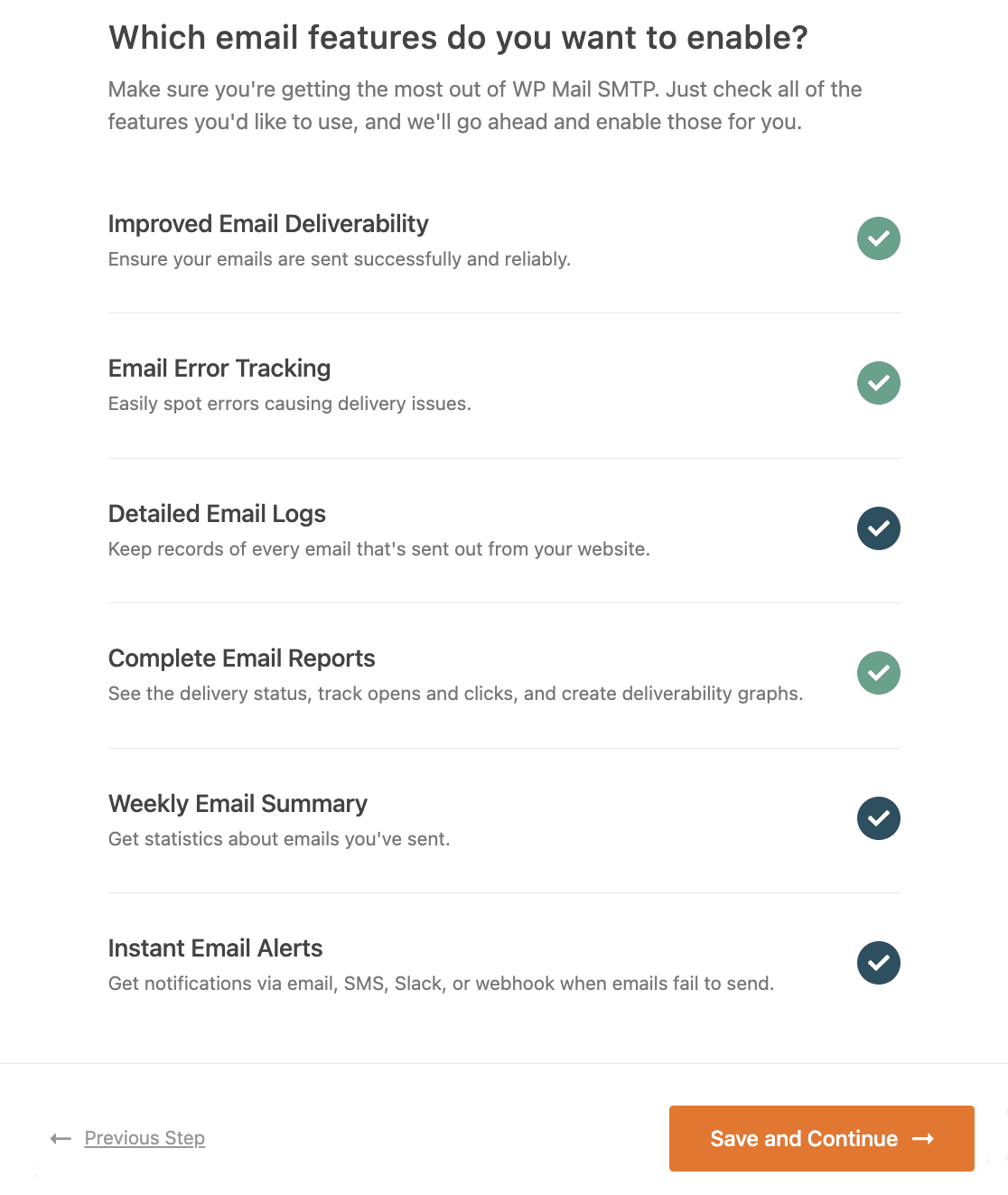
The email log will track:
- Password reset emails
- Contact form plugin notifications
- Marketing emails from your newsletter plugin
- Security alerts
- WordPress notifications
- And any order emails or WooCommerce plugin notifications.
Depending on your mailer, you’ll see statuses of:
- Sent
- Failed
- Delivered (if supported by your transactional email provider)
WP Mail SMTP stores all of this information in Complete Email Reports.
This WooCommerce email logging feature is super helpful because you can drill right down to individual emails to check if they were sent successfully. If you’re using a WooCommerce email customizer plugin, you can also check that your emails look the way you want them to.
You can also search for specific emails on the email log page. For example, you could display all sent order emails in one list.

We also recommend enabling Instant Email Alerts. These notifications let you know if your site fails to send an email so you can figure out what the problem is and get your emails working again.
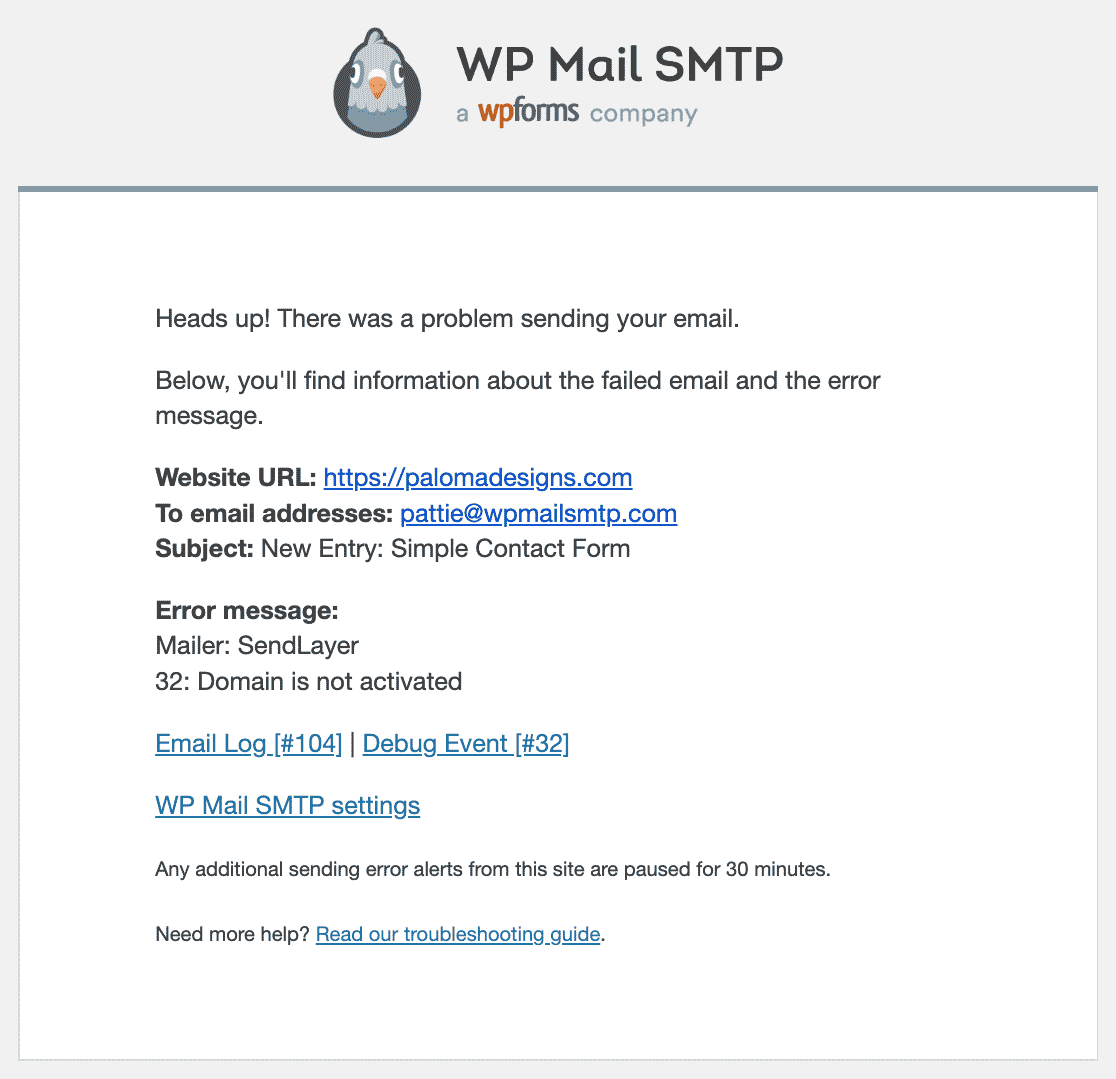
Next, there are some advanced email logging features to turn on.
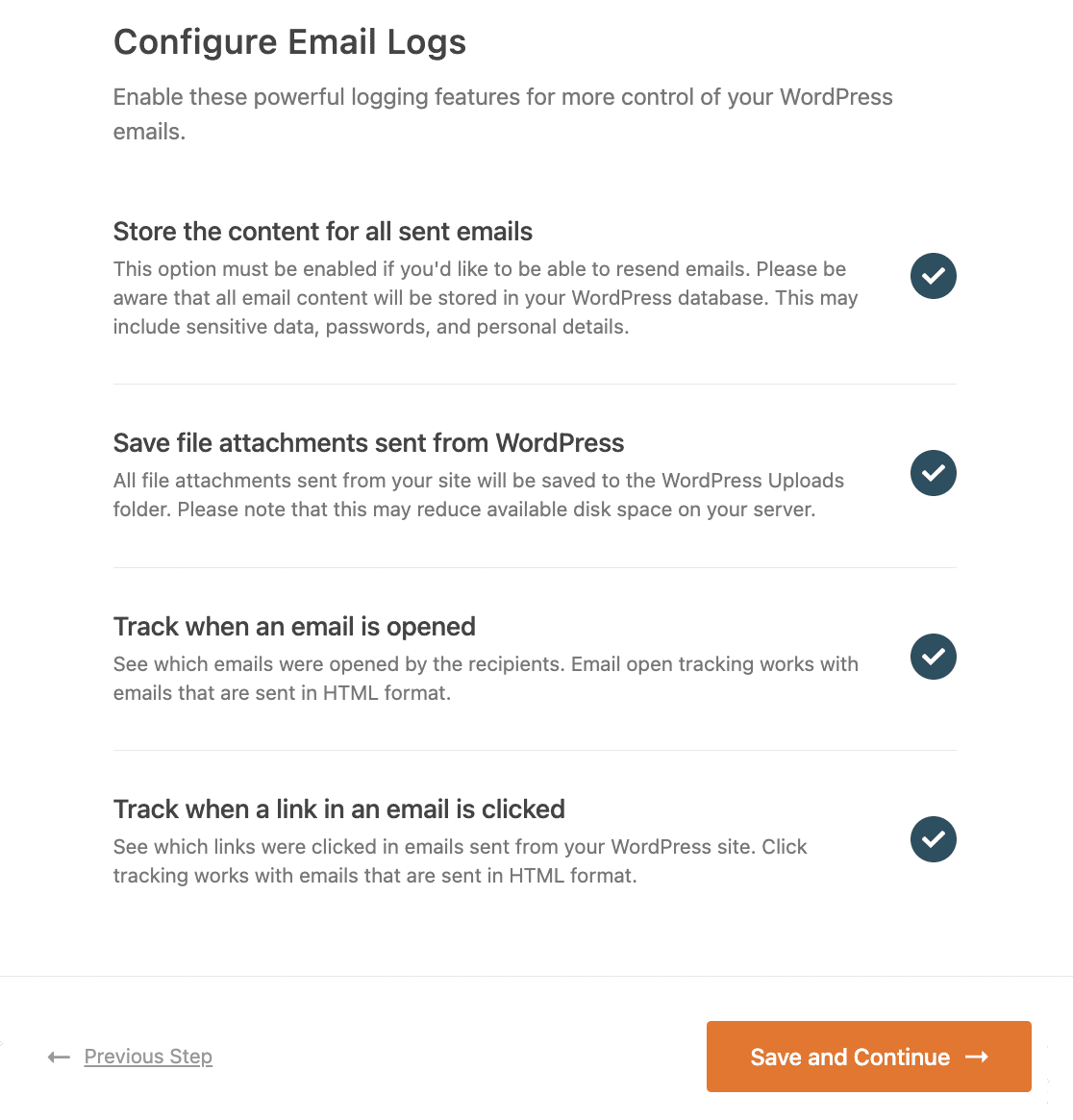
The first option lets you store the full content of your site’s emails. This is important if you want to be able to resend emails, which we’ll explain in the next step.
You can also save attachments if you want to be able to see any invoices that were included in the email.
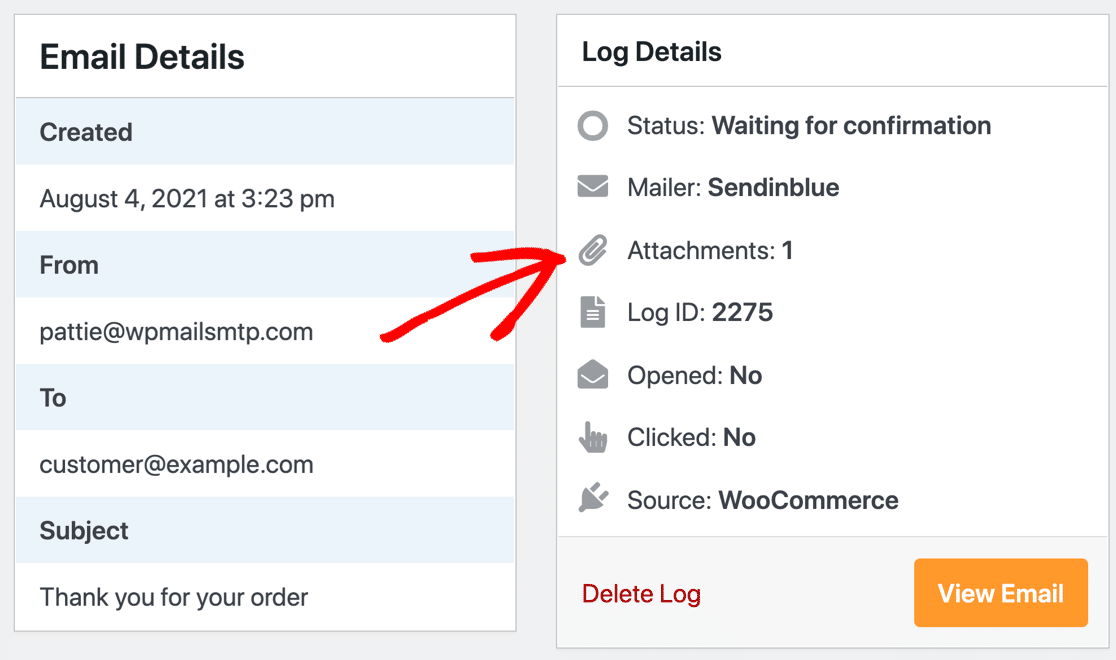
It’s really easy to print your WooCommerce email attachments from here.
And that’s not all! With WP Mail SMTP email logging, you can turn on open and click tracking to see if your customers are interacting with the emails your site is sending.
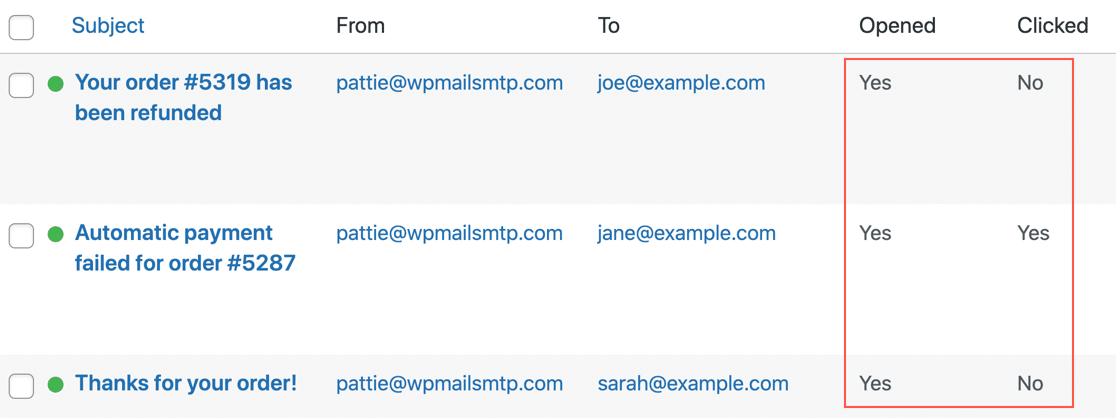
Another benefit of logging the email content is that it lets you resend WooCommerce emails. Let’s look at that next.
Step 5: Resend WooCommerce New Order Notification
In step 4, we talked about logging the full content of your emails using WP Mail SMTP. This saves a copy of every sent email in your WordPress database.
This is helpful if you want to be able to resend WooCommerce order emails.
For example, if a customer contacts you to say that they didn’t receive an order confirmation, you can resend the entire email from the Email Details screen.
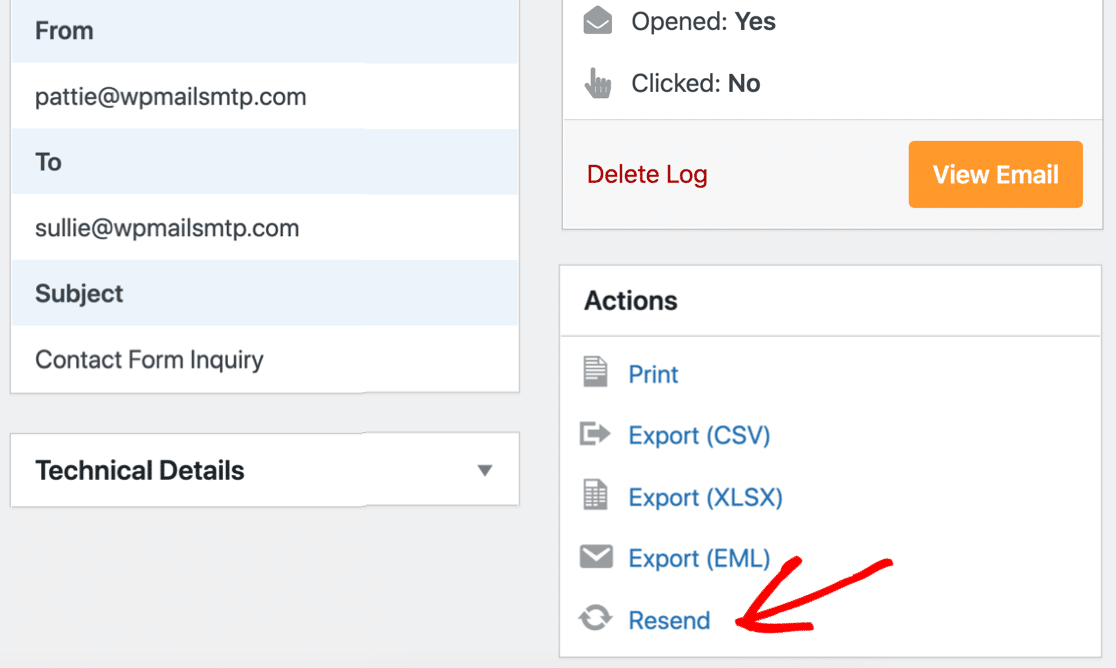
With this option, you can resend it to the same recipient or a different one. This is super helpful if your customer isn’t receiving order emails and they provide an alternative address.
And if you have WP Mail SMTP set up to save WordPress email attachments, those will also all be resent with the original email.
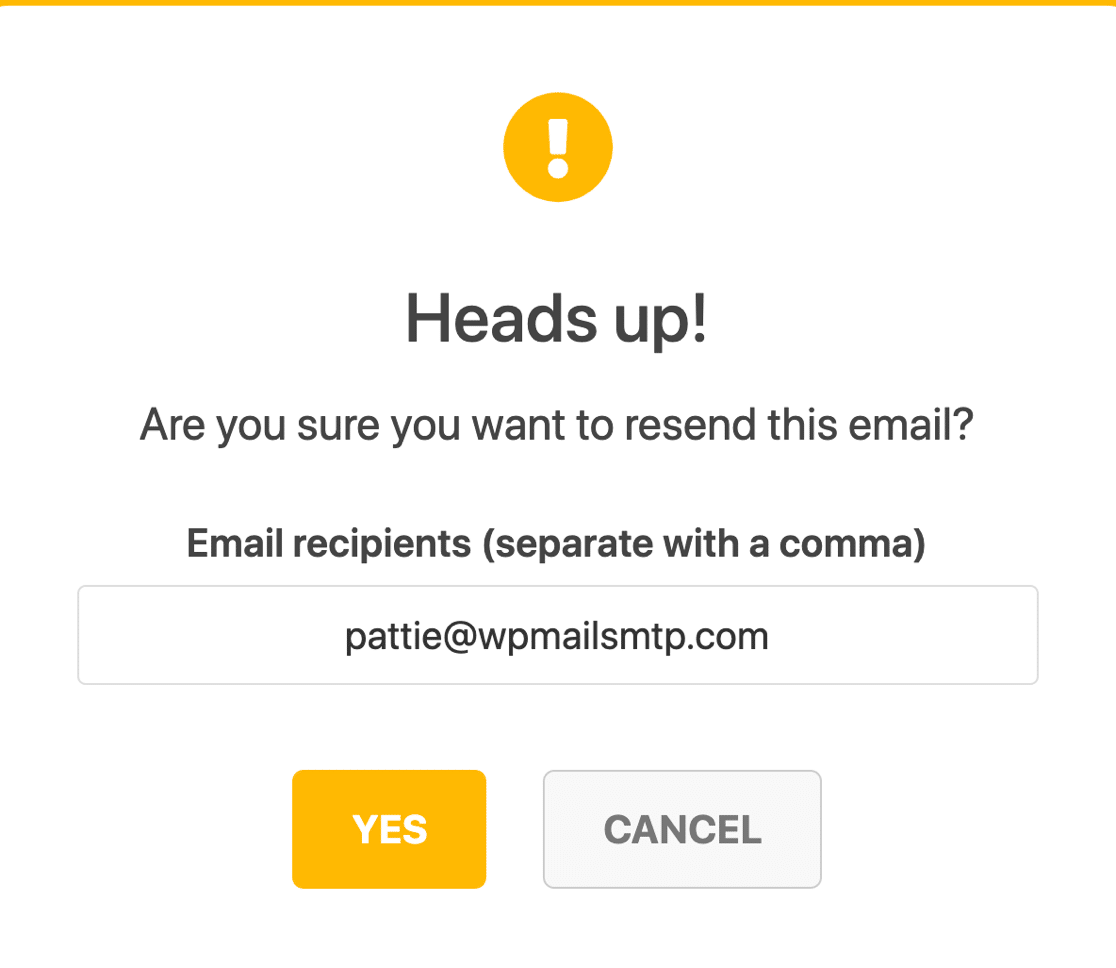
Did you notice that there’s also an option to print the email log? Check out our guide on how to print WooCommerce emails to see how it works.
If you need a fast way to resend multiple emails, you can also resend WooCommerce emails in bulk.
This is helpful if you had a temporary issue with your WooCommerce SMTP server. It’s easy to check all your Failed emails and send them again without opening each one individually.
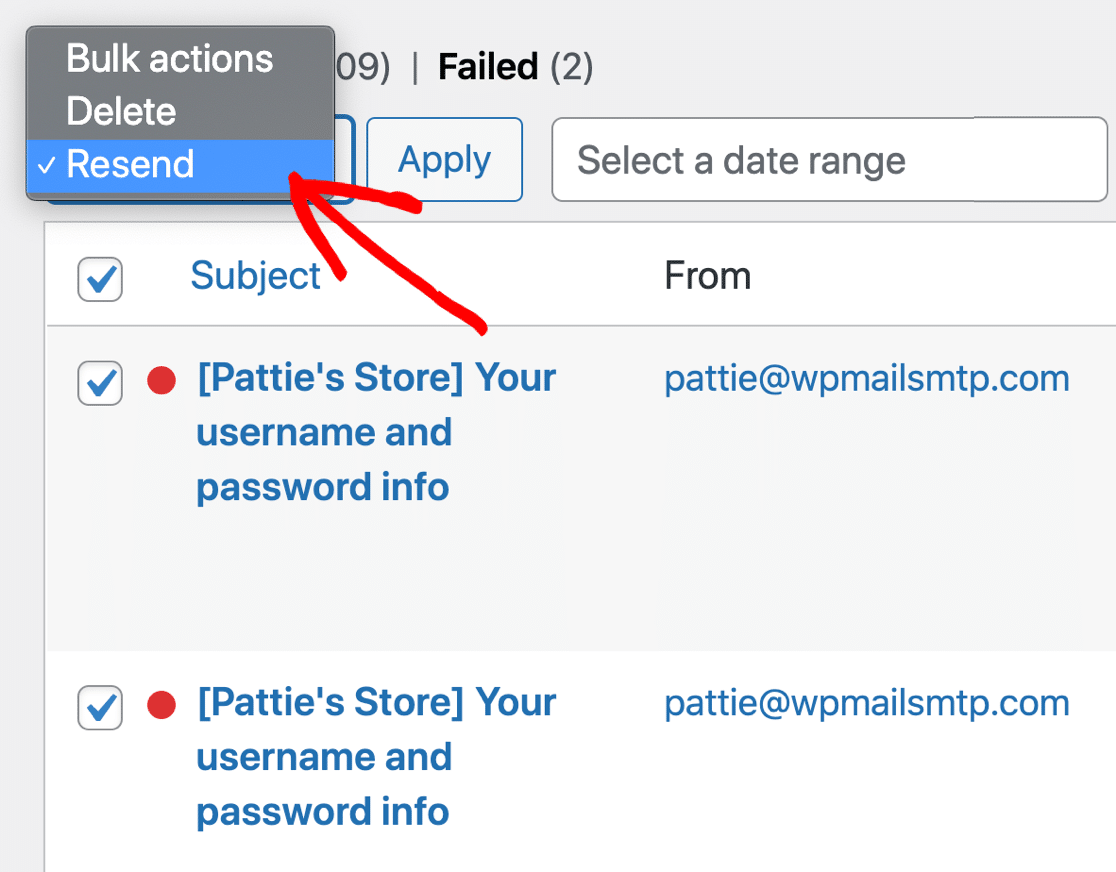
Here’s a final tip: you can use WP Mail SMTP to export your WooCommerce email logs to CSV, EML, or XLS! That means you can track or review your WooCommerce emails in any application. Check out how to log your WordPress emails to see how the export feature works.
Finally, we want to show you 1 more feature that’ll help you make sure WooCommerce is sending emails to customers.
Step 6. Monitor WooCommerce Email Deliverability
If you want to keep an eye on your WooCommerce emails, logging in to WordPress can be inconvenient. That’s why we recommend that you keep an eye on your weekly email summary.
WP Mail SMTP will email you every Monday with some statistics about your emails over the previous week.
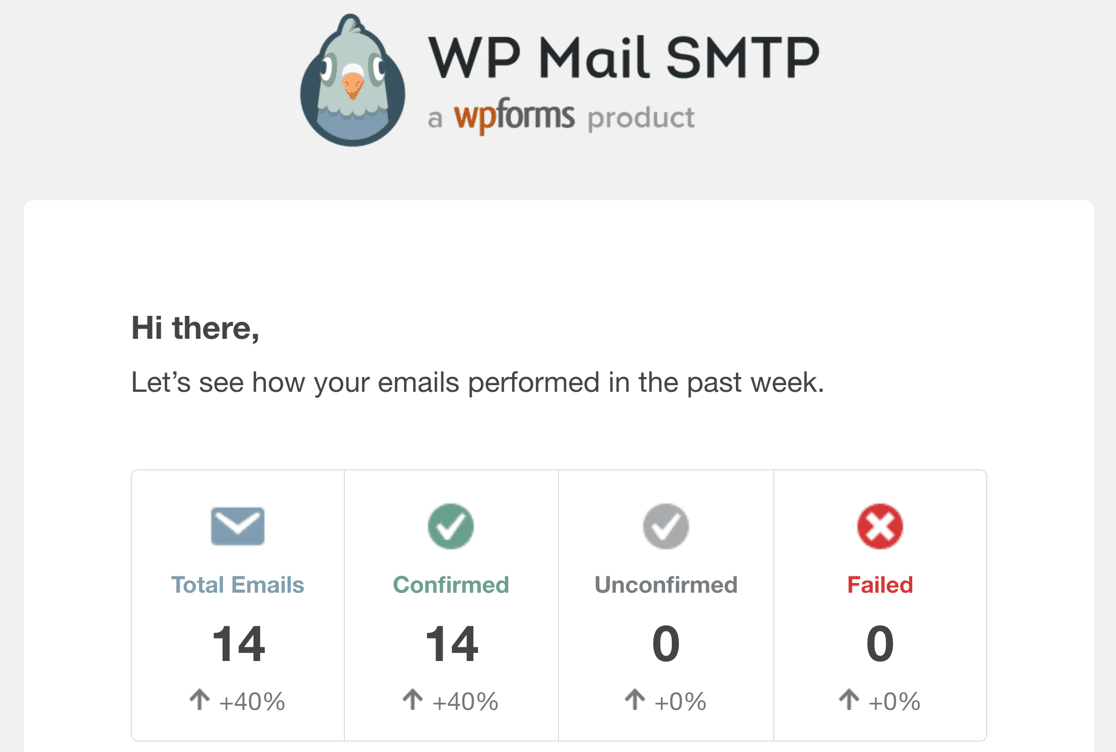
You can also see a breakdown of open and click-through rates by subject line. This lets you monitor your emails without logging in to WordPress.
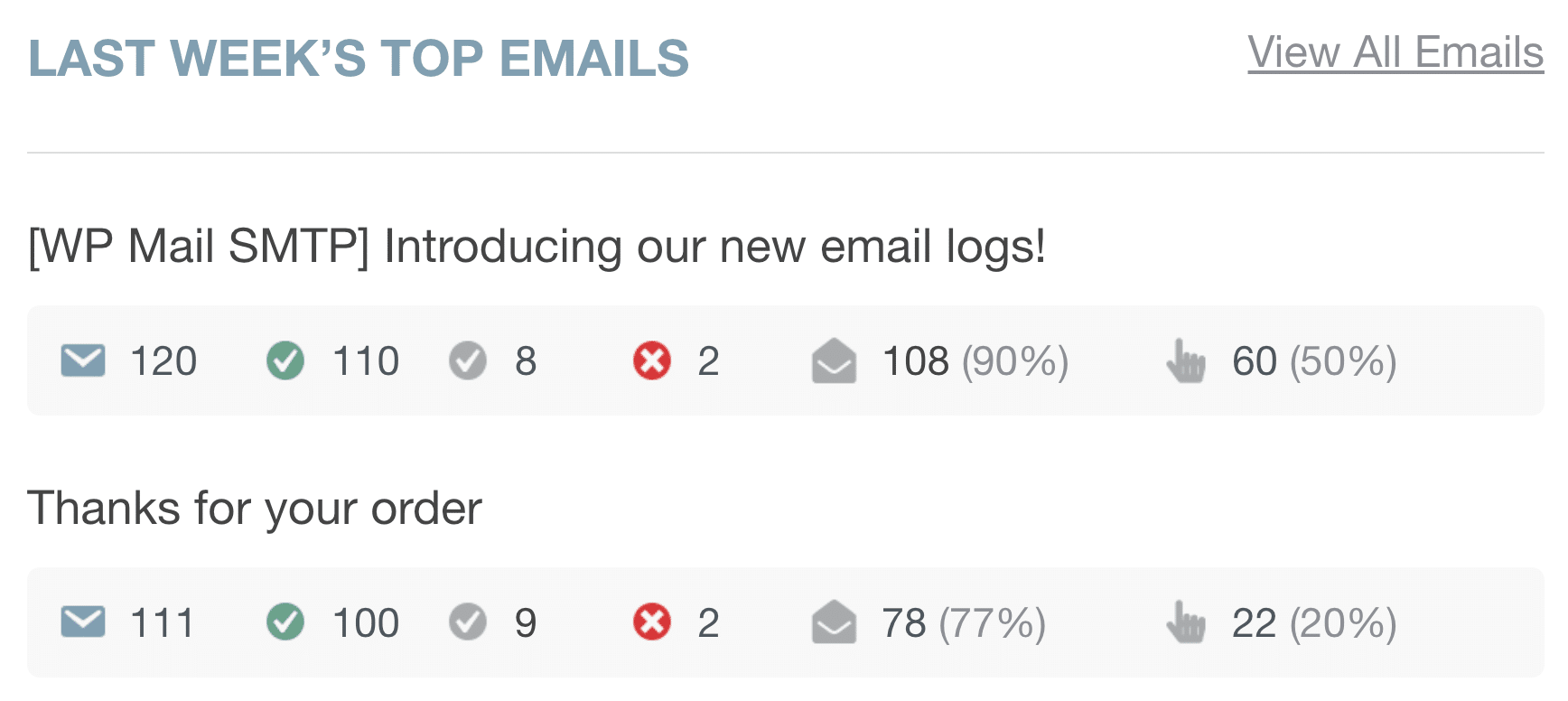
Any time you need more information, check out your WooCommerce email reports by logging in and heading to WP Mail SMTP » Email Reports.
Your email report gives you a broader overview of your emails, including open and click-through rates and delivery status.
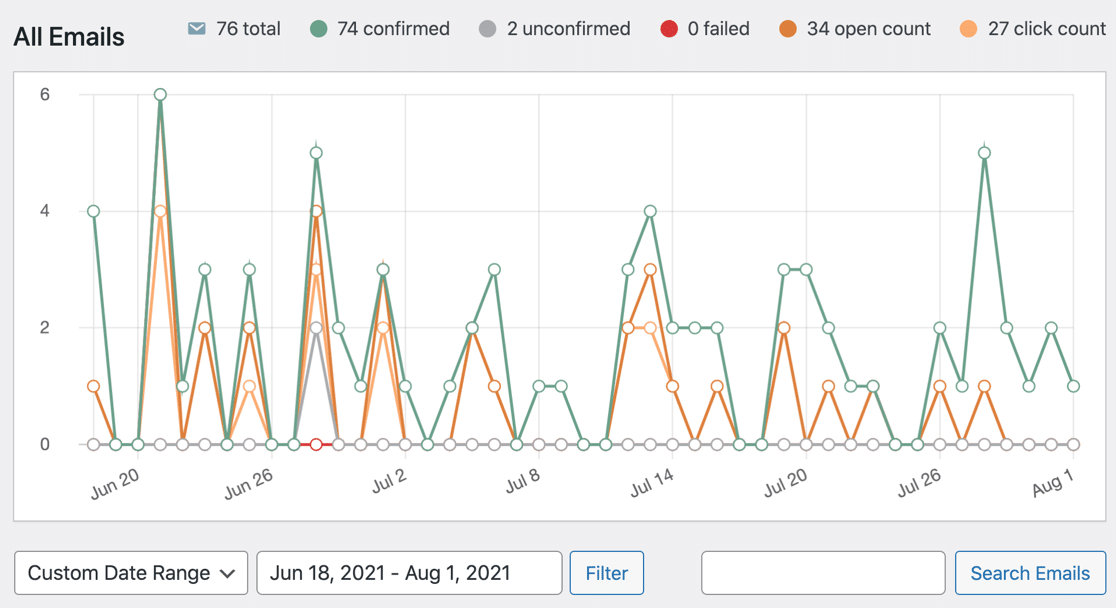
And that’s it! We’ve walked through all of the steps to fix WooCommerce not sending emails on your site.
If you’d like to get the most out of your WordPress emails, see our guide on best WordPress email plugins.
Fix Your WooCommerce Emails Now
FAQ about WooCommerce Order Notification and Email Issues
Are you still facing issues with your WooCommerce emails and notifications? Here’s some more information on possible fixes for your WooCommerce email problems.
How Do I See Sent Emails in WooCommerce?
You can easily see sent WooCommerce emails with the WP Mail SMTP plugin. It adds complete logging for WooCommerce email notifications.
You can easily see:
- The content of all sent WooCommerce email notifications
- Delivery status
- Whether the order email was opened and clicked.

You can also use WP Mail SMTP to resend WooCommerce order emails that fail, or forward them to a different email address. This is helpful if you want to test WooCommerce emails and see if they are going to spam.
Why Is WooCommerce Not Sending Emails When Paying With PayPal?
If you’re not receiving notifications for order purchases made with PayPal, this might be a simple update issue. Make sure that your WooCommerce and WooCommerce PayPal Payments plugins are updated to their latest versions. As soon as you update, your email notifications should work normally.
How Do I Test the Email Notification for My WooCommerce Store?
To test your WooCommerce email notifications, open your WordPress dashboard and go to WooCommerce » Preview Emails. The email preview tool lets you choose any specific WooCommerce email to preview. Plus, it includes an email testing feature. You can choose any WooCommerce email that you want to test and fill in the Mail To field to receive the test email at that address.
Next, Check Your DNS Records
Next, it’s time to think about your DNS records.
If you followed our guide when setting up your mailer service, you already know about SPF, DKIM, and DMARC records. These records often need to be added to your domain’s DNS for your emails to be delivered with the right authentication.
If you already have an email list, you might have SPF records already set up for that. It’s super important that you don’t add a second SPF record when setting up WP Mail SMTP because that can invalidate both of them.

Instead, you’ll want to merge the SPF records so they only occupy 1 line in your DNS.
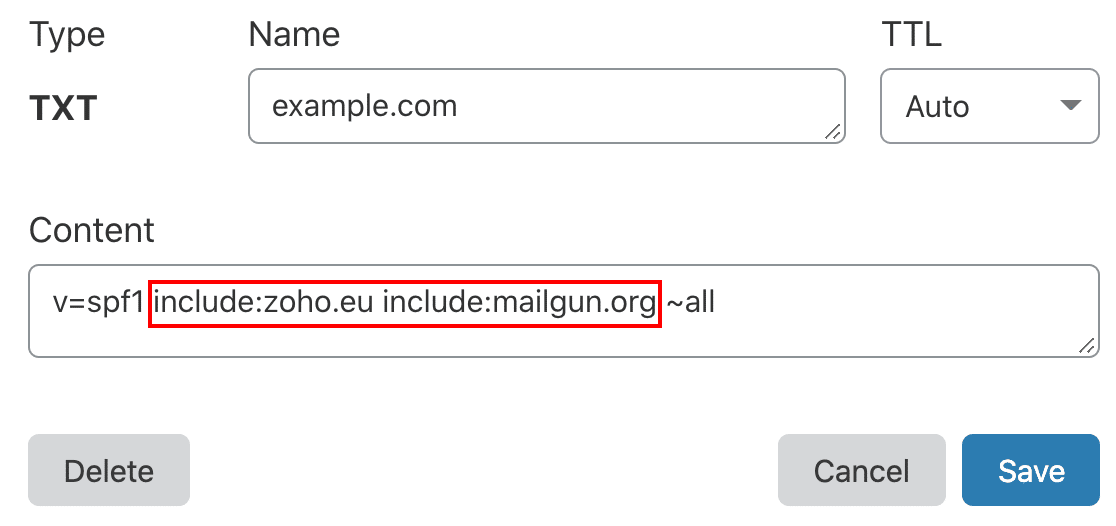
If you need more information on setting up your DNS, start with this guide to fixing multiple SPF records on your domain.
Also, if you’re setting up a new WooCommerce store, we recommend creating a separate email subdomain to protect your email reputation.
Ready to fix your emails? Get started today with the best WordPress SMTP plugin. If you don’t have the time to fix your emails, you can get full White Glove Setup assistance as an extra purchase, and there’s a 14-day money-back guarantee for all paid plans.
If this article helped you out, please follow us on Facebook and Twitter for more WordPress tips and tutorials.

